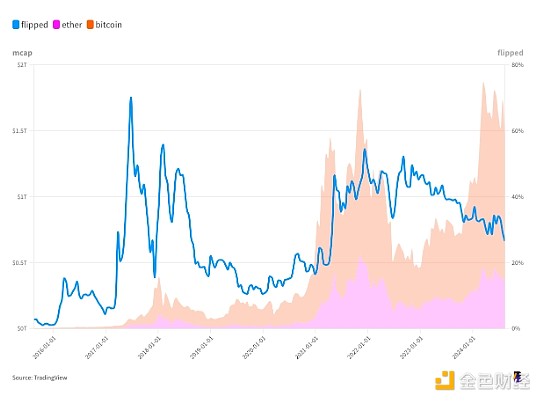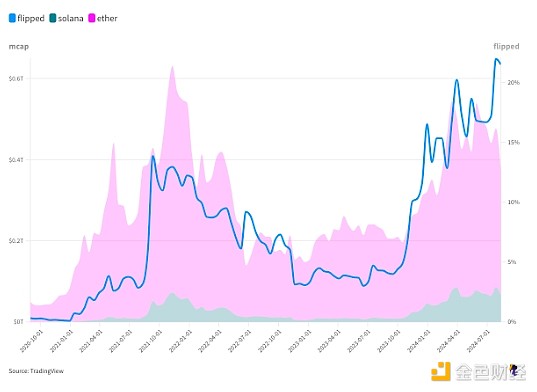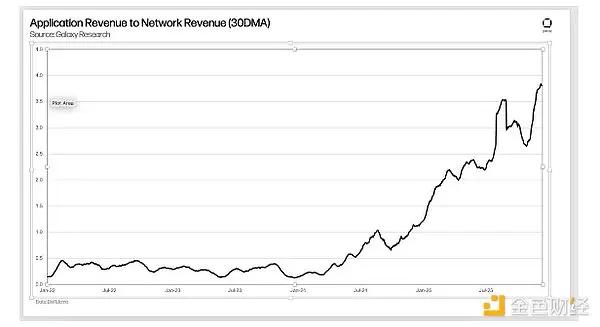Author: Katherine Ross, Blockworks; Translated by: Baishui, Jinse Finance
Rising with the bull market
Bitcoin is now over 640 days into its bull run — if you believe we are still in one.
Different models give different durations, but by my own calculations, the past three Bitcoin bull runs lasted 1,047 days (2015 to 2018) and 1,278 days (2018 to 2022).
So if Bitcoin is indeed destined to map to these four-year cycles (there are no guarantees), we are already more than halfway through the current cycle.
( I count November 9, 2022 as the start , when Bitcoin dropped below $15,670 after FTX shut down withdrawals.)
A few hundred days ago — back in January — Bitcoin’s bull run performance so far was roughly in line with the previous two cycles: a return of just under 4.5x.
However, during this cycle from 2015 to 2018, the price of Bitcoin quickly heated up. Between January and July 2017, the price of Bitcoin soared from $800 to over $2,800.
By the end of 2017, the price of Bitcoin eventually rose to nearly $20,000, setting an all-time high that was not broken for three years.

This is the point in time when Bitcoin really started to take off in the past three cycles
As the brown line in the chart above shows, Bitcoin today is tracking the most recent cycle more closely, between 2018 and 2022. Its year-to-date return is 278%, compared to the market return of 244% over the same period.
If the bull run is over, it would be the shortest bull run in Bitcoin’s history — not counting the two years of initial price discovery after the Genesis Block.
But if the bull run is still ongoing and Bitcoin price action is indeed still cyclical, then we would have to go higher from here to map onto these patterns, which does align with the outlook of some analysts.
Based on the length of the previous three markets, Bitcoin will remain bullish even into the middle of next year. (NFA, past performance is not indicative of future results, etc.)
Not all cryptocurrencies are as bullish as Bitcoin. Ethereum, in nearly three and a half years, has not come as far as Bitcoin.

The ETH/BTC ratio, which measures the cost of Ethereum in Bitcoin, has fallen by nearly half since the end of 2021
In the image above, the orange and pink shaded areas in the background show the market caps of Bitcoin and Ethereum, respectively. The areas are stacked so that a flip occurs when the smaller area takes up more than half of the total space.
The blue line tracks progress - it has been steadily falling since the 2021 bull market peak.
Meanwhile, Solana has never been closer to flipping Ethereum.
This time last year, Solana’s market cap was just 4% of Ethereum’s — or $9.3 billion to $217.2 billion. Now, it’s 22%, valued at $66 billion to $307.6 billion.

This is the same chart, but showing Solana flipping Ether status
It is worth mentioning that well-known trader Peter Brandt recently predicted that SOL will rise by 100% against ETH in the coming months.
In the previous bear market, the gap between solana and ether was quite large, even though SOL fell further due to its association with Sam Bankman-Fried.
However, we may need at least half a year of bull market for Brandt's call to come true.
It worked for me.
— David Canellis
Cryptocurrency is making a comeback
“Cryptocurrencies appear to be making a comeback once again.”
This is a direct quote from Barnes and Thornburg regarding the investment fund outlook.
84% of respondents believe that private investment activity in this sector will increase significantly in the coming year.
“59% of respondents also expect the total number of cryptocurrency-specific funds to increase over the next 12 months. This is a change from last year, when the majority of respondents said the current state of the cryptocurrency market had a significant negative impact on their organizations,” the report states.
Barnes and Thornburg surveyed nearly 140 venture capitalists, private equity, hedge funds and investors — including limited partners and sponsors in the U.S. Perhaps not surprisingly, AI was another hot sector for these folks (although recent market action suggests AI deals may have dried up for some investors).
Two main factors have contributed to the change in attitude: continued institutional adoption (duh) and a rebound in cryptocurrency prices.
“It’s been a year and a half since the FTX crash, and we’ve seen a massive recovery in Bitcoin and other cryptocurrencies,” said Scott Beal, partner at Barnes & Thornburg.
“The SEC’s approval of a Bitcoin ETF is a significant development for the industry and could also increase allocators’ willingness to invest in private crypto funds and other non-regulated products.”
Speaking of Bitcoin and Ethereum ETFs, the latter has managed to bear the weight of the positive momentum as the Bitcoin ETF continues to see some outflows.
“Given the challenging environment for spot ETFs (as evidenced by recent BTC spot ETF flows), and considering expected outflows once the Grayscale Ethereum Trust converts to an ETF, the outlook for an ETH spot ETF looks positive,” wrote Matteo Greco, research analyst at Finequia.
The 12-month outlook mentioned in the Barnes and Thornburg report happens to be another potentially bullish time frame for the cryptocurrency, depending on the outcome of the U.S. presidential election.
There are also reports that current Vice President Kamala Harris’ campaign is trying to reach out to cryptocurrency industry leaders, which could influence developments.
However, former President Donald Trump’s Republican campaign has been more vocal in its support for cryptocurrencies. FalconX’s David Lawant recently opined that the U.S. election could help break the current trend for cryptocurrencies.
Because, despite the possibility of positive catalysts, we are still at an awkward point in price action.
“Total open interest in Bitcoin has fallen by approximately 12% since the end of July, from $4.6 billion to $4.1 billion,” Finequia’s Greco wrote. “This decline highlights the large number of liquidations impacting digital asset markets, creating a snowball effect that has led to price declines, and reflects the strong correlation between market activity on centralized and decentralized exchanges and recent price action.”
“While reducing leverage can lead to short-term price declines, markets tend to view this positively as it reduces the risk of excessive leverage, which could lead to a more severe market correction if excessive leverage grows further and reaches unsustainable levels.”
There's a lot of potential for the future, but it's not necessarily helpful right now.
But it's also August and we're still in vacation mode. You know what we say: keep swimming.
– Katherine Ross Oct 14 '17 at 14:25
Q: What impact does summer have on noise signals?
Sometimes it dulls the noise signal. Sometimes it makes it really loud.
That certainly made the intense sell-off more dramatic and scary, but this summer's rally has still been strong.
Sometimes it would be nice if the noise was just a dull hum, but this is crypto and we’re working 24/7 so we always have to be prepared for the worst.
Just don't get too used to it. August is traditionally a slower month, but I feel like September will kickstart a lot of action.
– Katherine Ross Oct 14 '17 at 14:25
This is the second summer of the bull market, and some dampened enthusiasm is to be expected.
When the market is really hot, positive news like testnet releases, partnerships, and usage milestones can have a day-to-day impact on price.
In our current moment, all of these things barely register. But people still expect any news to be good.
News is news now. Even if it’s negative news. The market is going through all kinds of changes — which is probably the most bullish thing about crypto right now.
With crypto at current levels, and with all the macro, regulatory, and political uncertainty, how bad can things really get?
— David Canellis







